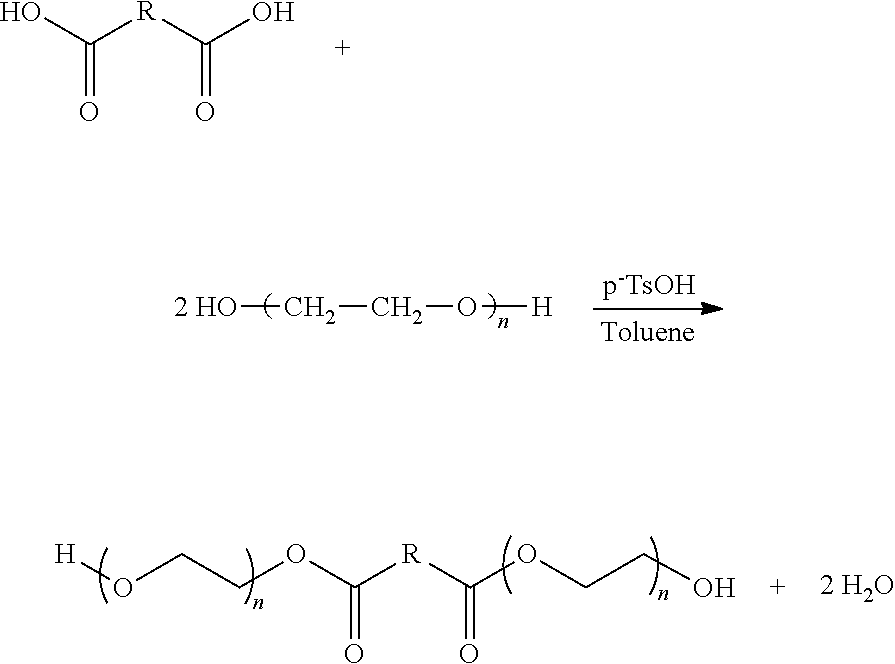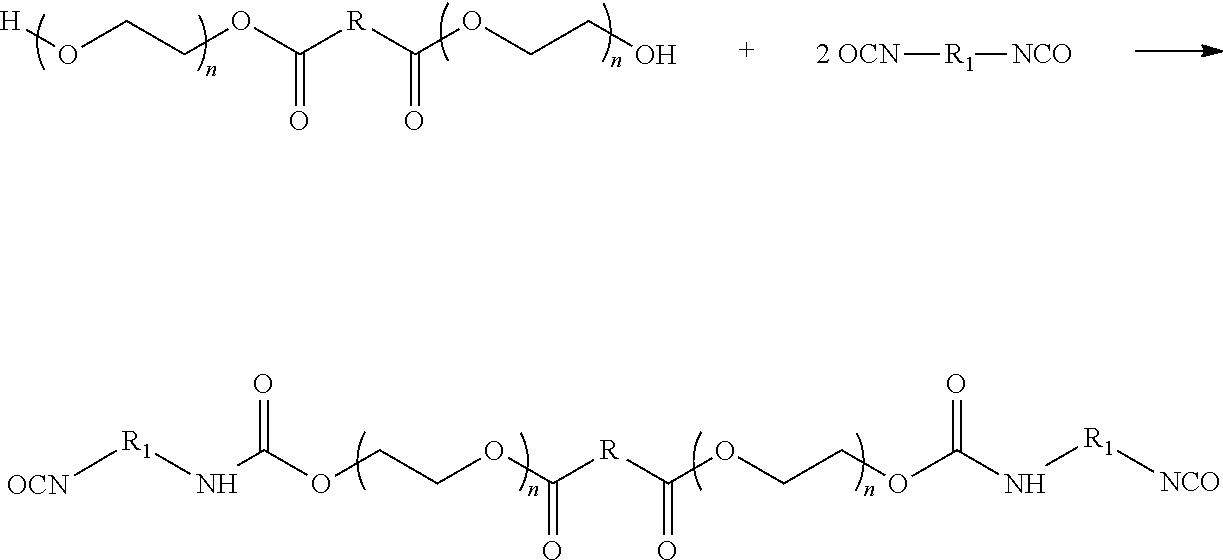Titanium dioxide pigment and manufacturing method
a technology of titanium dioxide and pigment, which is applied in the field of titanium dioxide pigment and manufacturing method, can solve the problems of affecting the desirable properties of pigment including opacity, brightness, tint strength and other optical properties of pigment, and the tendency of pigment particles to agglomerate in the coating formulation,
- Summary
- Abstract
- Description
- Claims
- Application Information
AI Technical Summary
Benefits of technology
Problems solved by technology
Method used
Image
Examples
example i
Synthesis of Inventive Polymer
[0105]By the following prophetic example, one manner in which the anti-agglomeration polymer of the inventive titanium dioxide pigment can by synthesized is illustrated.
[0106]First, a hydroxy terminated polyester is synthesized by a condensation reaction between polyethyleneglycol and adipic acid. Approximately 374 grams of ethylene glycol are placed in a one liter three necked flask equipped with a condenser, a gas inlet and a thermometer. The ethylene glycol is heated under approximately 76 mm Hg to 90° C., at which point 69 grams of adipic acid is added to the flask. The reaction mixture in the flask is then heated to 200° C. The water formed during the reaction is removed by distillation. After approximately five hours, the pressure in the flask is reduced to 25 mm Hg and the admixture was allowed to react for 36 hours. The molecular weight of the resulting polymer is estimated from the hydroxyl number to be approximately 2000.
[0107]Next, approximat...
example ii
[0118]The anti-agglomeration polymer of the inventive titanium dioxide pigment was synthesized using the procedure described below.
Step 1: Ester Formation
[0119]
[0120]A 500 ml three-neck flask was charged with 90 g poly(ethylene glycol) (Aldrich, MW 6k, 15 mmol), 1.095 g adipic acid (Aldrich, MW 146 g / mol, 7.5 mmol) 0.022 g of pTsOH para tolune sulfonic acid) (Aldrich, 2% catalyst based on acid) and 160 ml toluene (Aldrich). The flask was put in an oil bath, connected with Dean-Stark trap and reflux condenser. The outlet of the condenser was connected with a drying tower to prevent moisture absorption from air. The reaction media was heated to reflux under magnetic agitation. When all the solids were dissolved, the sample was tested using FTIR for the starting spectrum. It was refluxed further under agitation, and water was removed by azeotropic distillation, forcing the reaction towards the right. Water was collected from the bottom of the Dean-Stark trap. When no more water was dis...
example iii
Comparative Testing of HEUR Resins
[0126]A number of existing, commercially available hydrophobically modified, ethoxylated urethane (“HEUR”) resins, known to be useful as associative thickeners, were tested to determine if they could be effectively utilized as an anti-agglomeration polymer of a titanium dioxide pigment. The HEUR resins that were tested are shown in TABLE 2 below:
TABLE 2Sample HEUR ResinsProductProducerAcrysol RM 825Dow ChemicalAcrysol RM 2020Dow ChemicalBermodol PUR 2130Akzo NobelBermodol PUR 2150Akzo NobelBorchi Gel 075OMGBorchi Gel 0434OMGBYK-425BYKBYK-428BYKDSX 1514BASFDSX 3291BASFDSX 3515BASFK-Stay 730King IndustriesK-Stay 731King IndustriesK-Stay -740King IndustriesRheolate 644ElementisRheolate 655Elementis
[0127]The titanium dioxide pigment utilized in the tests described in this example (including the standard pigment) was a commercially available rutile titanium dioxide manufactured by Tronox LLC in accordance with the chloride process and sold in association...
PUM
| Property | Measurement | Unit |
|---|---|---|
| Fraction | aaaaa | aaaaa |
| Fraction | aaaaa | aaaaa |
| Fraction | aaaaa | aaaaa |
Abstract
Description
Claims
Application Information
 Login to View More
Login to View More - R&D
- Intellectual Property
- Life Sciences
- Materials
- Tech Scout
- Unparalleled Data Quality
- Higher Quality Content
- 60% Fewer Hallucinations
Browse by: Latest US Patents, China's latest patents, Technical Efficacy Thesaurus, Application Domain, Technology Topic, Popular Technical Reports.
© 2025 PatSnap. All rights reserved.Legal|Privacy policy|Modern Slavery Act Transparency Statement|Sitemap|About US| Contact US: help@patsnap.com



